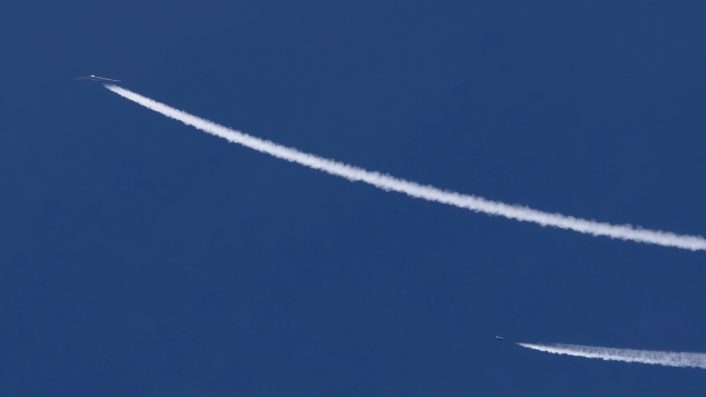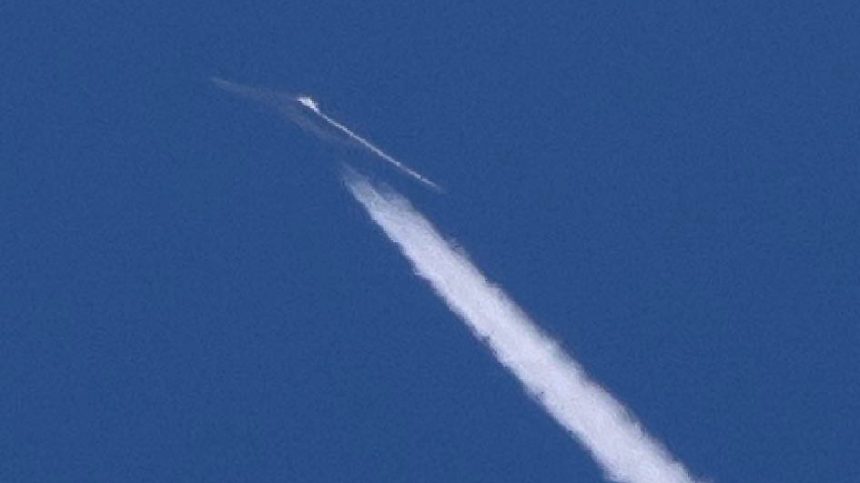Sightings of the B-21 Raider stealth bomber are becoming more frequent on the U.S. West Coast, as testing of the 6th generation bomber continues.
On Oct. 31, 2024, aviation photographer Jarod Hamilton took some stunning shots of a Northrop Grumman B-21 Raider that was involved in a test flight inside the R-2508 Complex, located in Southern California.
No goblins for Halloween, but I did see a ghost!#B21 #B21Raider pic.twitter.com/bNEBjGOi0g
— jmh.creates (@JarodMHamilton) November 1, 2024
B-21 Raider flying on October 31st in California #B21 #B21Raider pic.twitter.com/2Vap5mI5K4
— jmh.creates (@JarodMHamilton) November 2, 2024
As happened with other B-21 photos we talked about recently, these shots don’t reveal new information about the bomber, since it was already known that the Raider is a twin-engine aircraft, and its general shape was shown in images from its first flight. However, it’s once again notable to see the aircraft producing contrails during a test flight. Additionally, it’s safe to believe that the B-21 is equipped with a contrail sensor similar to that of the B-2, which notifies pilots when they need to adjust altitude to minimize contrail formation, although it’s evidently not being used in the current flight testing phase.
Here’s what Jarod told us about his sighting in a message:
I hiked four miles to scout out a new location for shooting fighter jets flying the Sidewinder low level. It was a pretty slow day for jet passes so I was focusing on photographing some aerial refueling that was happening overhead.
During some downtime, I noticed two contrails off in the distance and immediately had a feeling it was the B-21 with its chase plane. It made one big revolution and then the contrails disappeared and so did the Raider. I can’t say for sure how far away it was but it was definitely in the lower portion of the 2508 complex.
I was shooting with my Canon R5 with a 100-500 lens.
Well, quite a catch for a “slow day”!
B-21 Raider update
The Northrop Grumman B-21 Raider made its inaugural flight from Air Force Plant 42 in Palmdale on November 10, 2023. This initial flight paved the way for comprehensive testing at Edwards Air Force Base, California, home to the B-21 Combined Test Force (CTF). Here, three units are undergoing tests: one for airborne trials and two for ground-based evaluations. As the U.S. aims to secure a competitive edge amid evolving global threats, the B-21 is more than just an aircraft: it symbolizes a leap into the next era of strategic air capabilities.
Commander, Air Force Global Strike Command and Commander, Air Forces Strategic – Air, U.S. Strategic Command, Gen. Thomas Bussiere, alongside a panel of military and industry leaders, provided an in-depth update on the bomber at the 2024 ASC Conference. The discussion underscored a key milestone: static testing had concluded successfully for the G-1 unit, confirming the structural reliability of the aircraft and boosting confidence in its digital modeling. This completion now segues into fatigue testing, a critical stage for assessing long-term resilience under operational stresses.
Northrop Grumman has ensured the B-21 is designed with lessons from the B-2 Spirit in mind. The B-2’s maintenance-heavy nature posed challenges; thus, the B-21 was engineered to optimize operational readiness and reduce the logistical burden. Thomas Jones, president of Northrop Grumman Aeronautics Systems, expressed satisfaction with the current progress, noting the ability to conduct up to two test flights per week, with a vision for daily operations. This increased flight tempo aims to expedite the Raider’s path toward full-scale deployment.
B-21 Raider sighting
California, October 31, 2024#B21 #B21raider pic.twitter.com/iUtMX0EkxK
— jmh.creates (@JarodMHamilton) November 2, 2024
Shortly after the B-21 began its test flights, Northrop Grumman received the contract for Low-Rate Initial Production (LRIP) of the Raider. While details of the contract remain under wraps, it is known that the unit cost was previously cited at around $692 million, based on initial Air Force estimates. Production is advancing with six airframes currently in various stages of assembly, including the aircraft named “Cerberus,” which undertook the inaugural flight.
Amid these developments, Gen. David W. Allvin’s remarks at the Military Reporters and Editors conference in October 2024 suggested a possible expansion in the B-21’s mission profile. With the NGAD (Next Generation Air Dominance) program under scrutiny due to its significant costs, estimated at $300 million per manned unit, the Air Force is considering alternative paths. The B-21, initially intended for long-range strategic strikes, could potentially serve in a complementary air dominance role, reflecting a shift in strategic thinking. Although Allvin did not explicitly state that the Raider would take on air-to-air missions, his comment—“We have not taken that off the table”—left the possibility open for interpretation.
The NGAD initiative, conceived as a suite of systems that includes manned aircraft alongside autonomous drones known as Collaborative Combat Aircraft (CCA), is pivotal to the Air Force’s vision. These unmanned systems offer ISR (Intelligence, Surveillance, and Reconnaissance), decoy, and strike capabilities, functioning cohesively within a distributed operational framework. However, the high cost of the NGAD manned platform, almost triple that of an F-35, necessitates a balanced approach, prompting consideration of how the B-21 might fill strategic gaps.
If tasked with an air-to-air role, the B-21 could operate as a formidable “arsenal plane,” deploying ultra-long-range missiles like the AIM-260 Joint Advanced Tactical Missile (JATM) to suppress or deter enemy fighter formations. This would leverage the Raider’s stealth profile and advanced data-linking systems, ensuring seamless integration with accompanying CCAs and manned NGAD aircraft.
The Raider’s versatility might extend to Suppression of Enemy Air Defenses (SEAD) and Destruction of Enemy Air Defenses (DEAD) missions, where it could launch anti-radiation missiles or deploy radar-baiting decoys. Its cutting-edge sensor fusion and digital architecture provide a robust platform for processing electromagnetic data and coordinating complex operations. With powerful on-board generators hinted at in past reports involving fuel cell maintenance facilities, the B-21 is well-equipped for the energy demands such missions entail.
This expanded vision of the B-21’s capabilities highlights the dynamic nature of modern air warfare. As adversaries develop more sophisticated defenses, the Air Force seeks adaptable solutions. The Raider’s potential as an air dominance asset aligns with these strategic imperatives, positioning it not just as a bomber but as a multifaceted platform capable of adapting to various mission sets.
The coming months may reveal whether the Air Force decides to officially expand the B-21’s role. As discussions regarding the NGAD’s future progress, Northrop Grumman’s Kathy Warden has confirmed the company’s readiness to scale up production if more Raiders are required. While Secretary of the Air Force Frank Kendall has noted that ongoing assessments could impact the final number of bombers, any extension of the Raider’s mission could strengthen its importance in the U.S. arsenal, ensuring it remains a cornerstone of strategic air power for years to come.
We’ll see. In the meantime, Jarod and other photographers will hopefully have more chances to capture stunning images of the Raider during its flight tests.
A huge thank you to Jarod Hamilton for sharing his experience and granting us permission to use his photos. Be sure to check out and follow him on X and Instagram.










